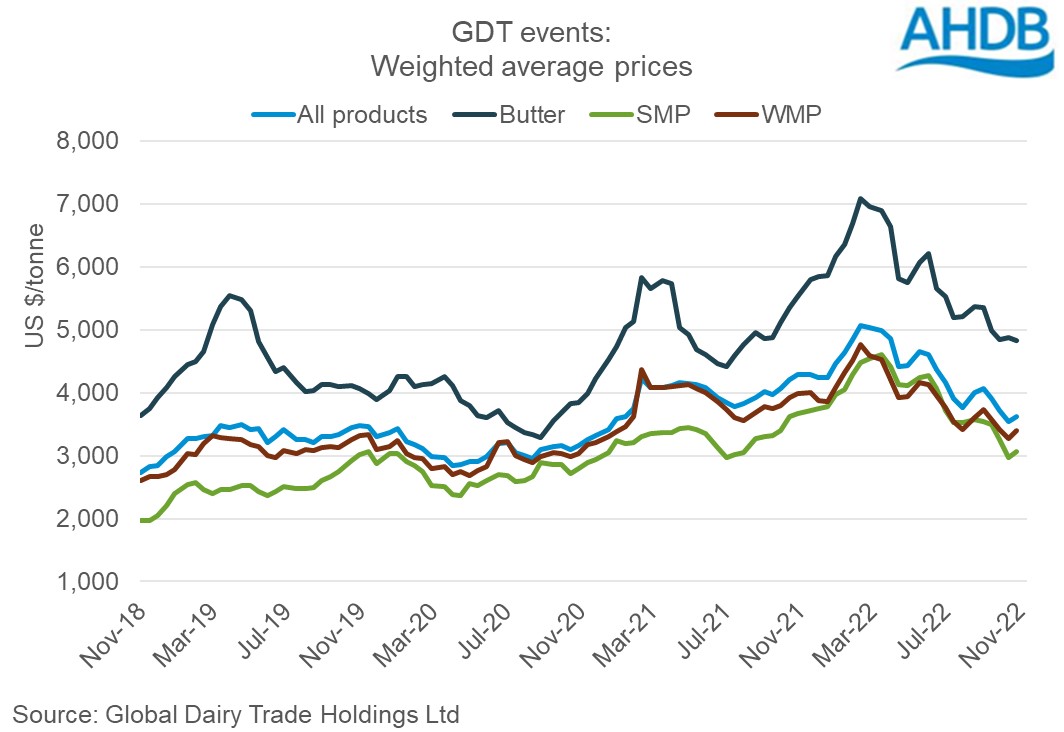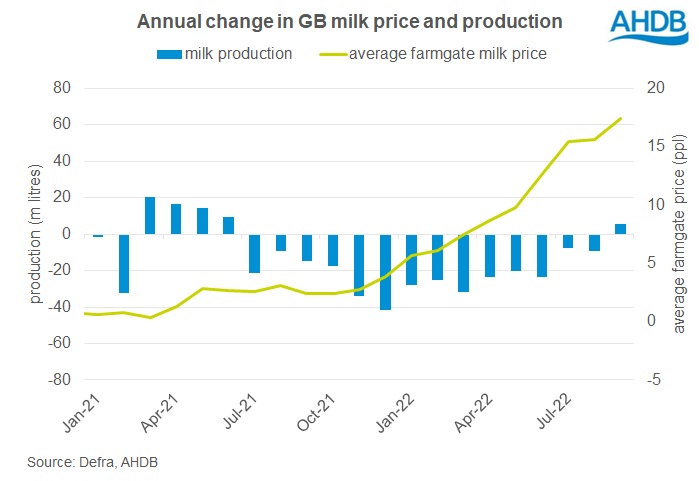Quarterly dairy market update - Q3 2022
Thursday, 24 November 2022
The third quarter of 2022 (Jul-Sep) has seen a recovery in milk production as higher prices ease pressure on farm margins. While strong market returns early in the year allowed milk buyers to increase milk prices and alleviate some on-farm cash flow pressures, the recent weakness in dairy product markets may limit their ability to maintain prices at current high levels.
Milk production
Following the Milk Forecasting Forum in September, our forecast for GB milk production was revised up marginally to account for better than expected herd retention rates. For the 2022/23 season, production is now expected to reach 12.26bn litres, about 30m litres more than we anticipated in the spring. The improvement in milk prices over the spring and summer will have helped to offset the rising input costs faced by dairy farmers, reducing the need to cut herd numbers.
With a mild, wet autumn following the hot dry summer, improved grass growth, combined with the strong milk prices, will have encouraged production. Production in October surpassed forecasted levels by 4%, reaching 1,040m litres or 33.55m litres/day.
![]()
However, there remains a risk that yields or retention rates could drop again through the winter months as input costs continue to pressure farm margins. The timing of purchases will have been particularly influential on cash flows this year given how volatile prices have been. Those who managed to arrange fixed deals on key inputs such as feed and fertiliser in advance of the large spikes in prices will have likely fared better in the past year, with less pressure to reduce feeding or sell off cows. But, the full extent of price rises is yet to be realised for some farmers, particularly those whose fixed energy contracts have recently (or have yet to) come to an end.
Product availability
With cumulative milk production remaining below previous year levels so far in 2022 (Jan-Sep), both in the UK and across the EU as a whole, availability of manufactured dairy products has remained tight. In the UK, supplies of butter were down on the year in the first half of the year. Cheese and milk powders both saw small gains in availability, mainly driven by trade fluctuations.
The situation in the EU is similar, with low milk supplies and reduced solids impacting on production, but lower exports offsetting some of this. For cheese and milk powders, uncompetitive pricing, plus firm domestic demand, has reduced exports, leading to improvements in availability. Butter supplies however remained tight as of August 2022. According to the September report from the Milk Marketing Observatory, estimated stock levels have improved but remain relatively low.
Tight supplies and limited growth in global milk production for 2022 supported dairy product prices in the first part of the year. However, the high prices, combined with general inflation have impacted on demand, softening dairy commodity markets. Prices at GDT auctions have been steadily declining since the spring.

Farmgate prices
Farmgate milk prices in GB, excluding aligned contracts, reached 47.03ppl on average in August 2022. Prices have been rising steadily since the spring of 2021, primarily in line with rising commodity market values. Higher input costs accelerated the increase in prices however as milk buyers were keen to ensure sufficient cashflow on farms to stem the downward trend in milk production which has been occurring since the summer of 2021.

Price increases have slowed in recent months, with fewer and smaller increases declared for the final months of 2022. In fact, for the first time this year, price holds were in place for the majority of contracts in November.
Market returns have stagnated in recent months, as milk supplies improved and demand has weakened. The rising costs of food and drink is changing consumer behaviours, and higher prices of dairy products are negatively impacting sales.
This delicate balance between tight supplies and declining demand suggests some risk to farmgate prices going into 2023 in our view. Processors may find it difficult to negotiate further price increases to support the current high farmgate prices in the current economic environment. With farm production costs remaining at high levels, any reduction in milk prices could trigger lower production, particularly as yields will be more dependent on purchased feed than grazing.
Sign up for regular updates
You can subscribe to receive Dairy market news straight to your inbox. Simply fill in your contact details on our online form and select the information you wish to receive.
While AHDB seeks to ensure that the information contained on this webpage is accurate at the time of publication, no warranty is given in respect of the information and data provided. You are responsible for how you use the information. To the maximum extent permitted by law, AHDB accepts no liability for loss, damage or injury howsoever caused or suffered (including that caused by negligence) directly or indirectly in relation to the information or data provided in this publication.
All intellectual property rights in the information and data on this webpage belong to or are licensed by AHDB. You are authorised to use such information for your internal business purposes only and you must not provide this information to any other third parties, including further publication of the information, or for commercial gain in any way whatsoever without the prior written permission of AHDB for each third party disclosure, publication or commercial arrangement. For more information, please see our Terms of Use and Privacy Notice or contact the Director of Corporate Affairs at info@ahdb.org.uk © Agriculture and Horticulture Development Board. All rights reserved.

